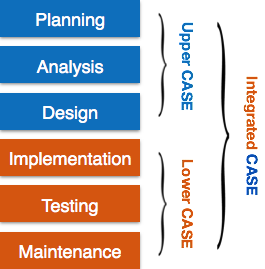CASE stands for Computer Aided Software Engineering. It means, development and maintenance of software projects with help of various automated software tools.
There are number of CASE tools available to simplify various stages of Software Development Life Cycle such as Analysis tools, Design tools, Project management tools, Database Management tools, Documentation tools are to name a few.
Use of CASE tools accelerates the development of project to produce desired result and helps to uncover flaws before moving ahead with next stage in software development.
CASE Tools
CASE tools are set of software application programs, which are used to automate SDLC activities. CASE tools are used by software project managers, analysts and engineers to develop software system.There are number of CASE tools available to simplify various stages of Software Development Life Cycle such as Analysis tools, Design tools, Project management tools, Database Management tools, Documentation tools are to name a few.
Use of CASE tools accelerates the development of project to produce desired result and helps to uncover flaws before moving ahead with next stage in software development.
Components of CASE Tools
CASE tools can be broadly divided into the following parts based on their use at a particular SDLC stage:- Central Repository - CASE tools require a central
repository, which can serve as a source of common, integrated and
consistent information. Central repository is a central place of
storage where product specifications, requirement documents, related
reports and diagrams, other useful information regarding management is
stored. Central repository also serves as data dictionary.

- Upper Case Tools - Upper CASE tools are used in planning, analysis and design stages of SDLC.
- Lower Case Tools - Lower CASE tools are used in implementation, testing and maintenance.
- Integrated Case Tools - Integrated CASE tools are helpful in all the stages of SDLC, from Requirement gathering to Testing and documentation.

